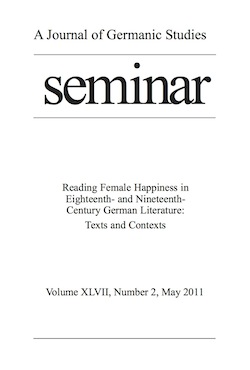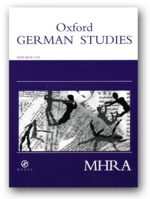Seminar: A Journal of Germanic Studies
Volume 50, Number 1 / February 2014
Representations of War Experiences from the Eighteenth Century to the
Present
Link to the journal: http://utpjournals.metapress.com/content/j1843g55087g/
This issue contains:
Introduction: Representations of German War Experiences and the Legacy of the Second World War – by Susanne Vees-Gulani, Stephan Jaeger
The Study of German War Experiences in Context – Questions of how to represent violence and war have strongly influenced the German social, cultural, political, and historical imaginary. Particularly since the early 1990s critical discussions on German war experiences both at the front and at home and their depictions have been a dominant theme in the culture sections of German newspapers as well as in the academy. These
discussions focus primarily on Germany during the Second World War with a special emphasis on the experience of German wartime suffering during the air war and during the flight and expulsion from the East (e.g. Assmann; Cohen-Pfister and Wienroeder-Skinner; Cooke and Silberman; Schmitz; Schmitz and Seidel-Arpaci; Taberner and Berger; Vees-Gulani; Wilms and Rasch; cf. also Süß, reviewed by Peter Fritzsche in this issue).
While these debates specific to the Second World War are necessary and important, this special issue hopes to expand this discourse beyond its restrictive temporal focus. Taken together, the contributions offer a clearer picture of the continuations, patterns, breaks, and places of German depictions of war and violence and their cultural memorialization
from the eighteenth century to the present. It is thus not the aim of the contributions simply to recall the contents of such representations of German war experiences but instead to concentrate on the processes and concerns of war representations…(excerpt from Introduction by Susanne Vees-Gulani, Stephan Jaeger)
Also in this issue:
Stockende Kampfmaschinen: Die Problematik des enthusiastischen Kriegshelden bei Wieland und Lessing – by Cornelis Van der Haven
(R)Evolution: From Edelleute to Edelmenschen – Bertha von Suttner’s Pathway to Peace – by Helen G. Morris-Keitel
The Haptic Horrors of War: Towards a Phenomenology of Affect and Emotion in the War Genre in Germany, 1910s to 1950s – by Jaimey Fisher
Reclaiming “geballte linke Energie”: War in Alexander Kluge’s Docufiction Heidegger auf der Krim – by Gunther Martens
The Aesthetics of Collective Innocence: Shifting Narratives about Flight and Expulsion after Ostpolitik – by Jeffrey Luppes
Claiming the Second World War and Its Lost Generation: Unsere Mütter, unsere Väter and the Politics of Emotion – by Laurel Cohen-Pfister
Reviews
Johannes Birgfeld. Krieg und Aufklärung: Studien zum Kriegsdiskurs in der deutschsprachigen Literatur des 18. Jahrhunderts, reviewed by Sarah Vandegrift Eldridge
Benjamin Ziemann. Contested Commemorations: Republican War Veterans and Weimar
Political Culture, reviewed by Jesse Kauffman
Tim Grady. The German-Jewish Soldiers of the First World War in History and
Memory, reviewed by Richard E. Frankel
Dietmar Süß. Tod aus der Luft: Kriegsgesellschaft und Luftkrieg in
Deutschland und England, reviewed by Peter Fritzsche
Isabel Capeloa Gil and Adriana Martins, eds. Plots of War: Modern Narratives
of Conflict, reviewed by Brad Prager
Jan Mieszkowski. Watching War, reviewed by Michael D. Richardson
**********
Oxford German Studies
Volume: 43, Number: 1 (March 2014)
SPECIAL ISSUE: ‘Post-War Literature and Institutions’
Link to this issue: http://www.maneyonline.com/toc/ogs/43/1
Throughout history and across cultures, institutions inevitably influence who we are, who we think we once were, how we write, and how we read. Since the middle of the twentieth century, the formative significance of cultural institutions and their plurality have been especially theorized for authorial subjectivity, literary style and our reception of literature.
After the Second World War, under the surveillance of Communist states, during the boom and crash of freer markets, the events of the Sixties and Seventies and now the greater movement of peoples bound together by new communicative technologies, institutions have liberated and repressed – giving rise to creativity. This special issue examines how authors and their literary narratives written in German have been fortified,
destabilized and otherwise shaped by organisations in both parts of a divided Germany and the contemporary landscape at home, abroad and online. The volume’s post-war scope is framed by introductory and concluding articles on the intersection of literature and institutions in addressing a National Socialist past.
————————————————————————
PREFACE
Seán M. Williams and W. Daniel Wilson
Oxford German Studies, Vol. 43, No. 1: 1-3.
————————————————————————
IRRECONCILABLE DIFFERENCES: THE TROUBLED FOUNDING OF THE LEIPZIG
INSTITUTE FOR LITERATURE
Marina Micke and Matthew Philpotts
Oxford German Studies, Vol. 43, No. 1: 5-19.
————————————————————————
BEFORE CHAMISSO: THE ROLE OF THE MUNICH DAF WRITING COMPETITIONS AND ANTHOLOGIES IN THE PROMOTION OF A ‘DEUTSCHE LITERATUR VON AUßEN’, 1979-1987
Chantal Wright
Oxford German Studies, Vol. 43, No. 1: 20-36.
————————————————————————
PRIZE GERMANS? CHANGING NOTIONS OF GERMANNESS AND THE ROLE OF THE AWARD-WINNING AUTHOR INTO THE TWENTY-FIRST CENTURY
Rebecca Braun
Oxford German Studies, Vol. 43, No. 1: 37-54.
————————————————————————
SUBVERTING THE INSTITUTIONALIZED READING TOUR: RAFIK SCHAMI AND DANIEL
KEHLMANN
John D. Pizer
Oxford German Studies, Vol. 43, No. 1: 55-68.
————————————————————————
THE LONG MARCH THROUGH THE INSTITUTIONS: FROM ALICE SCHWARZER TO POP FEMINISM AND THE NEW GERMAN GIRLS
Emily Spiers
Oxford German Studies, Vol. 43, No. 1: 69-88.
————————————————————————
‘INSTITUTIONALIZED STORIES’: CHILDHOOD AND NATIONAL SOCIALISM IN
CONTEMPORARY GERMAN MUSEUM DISPLAYS
Alexandra Lloyd
Oxford German Studies, Vol. 43, No. 1: 89-105.




